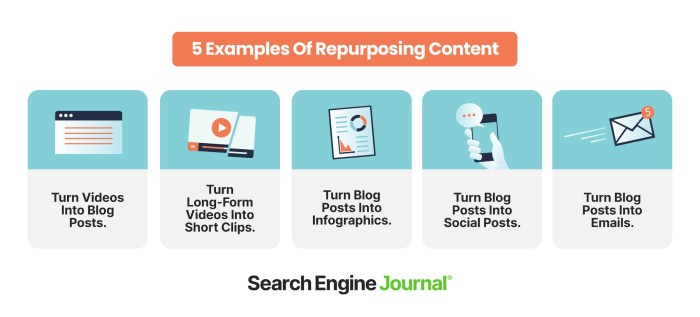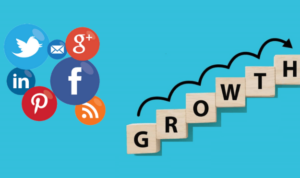Content Repurposing Techniques: Dive into the world of transforming your content to reach new heights of engagement and success. From defining strategies to exploring different types, this guide has it all.
Discover the secrets behind successful repurposing and learn how to leverage tools and platforms effectively for maximum impact.
Overview of Content Repurposing Techniques
Content repurposing techniques are like giving your old stuff a fresh new look, but in the digital world. It’s all about taking existing content and transforming it into something new and exciting to attract more eyeballs. And let me tell you, the benefits are no joke!
When you repurpose content, you save time and effort by not starting from scratch every time. Plus, you can reach a wider audience by presenting the same message in different formats across various platforms. It’s like hitting two birds with one stone, ya know?
Benefits of Repurposing Content
- Increases brand visibility and awareness
- Boosts rankings with fresh content
- Engages different audience segments
- Maximizes ROI by getting more mileage out of existing content
Successful Content Repurposing Strategies
Ever heard of turning a blog post into a podcast episode? Or how about creating an infographic from a data-heavy report? These are just a few examples of successful content repurposing strategies that have proven to be effective in reaching and engaging audiences across different platforms.
Types of Content Repurposing
Yo, when it comes to content repurposing, there are different types of content that can be flipped and reworked to reach a fresh audience. Check it out:
Written Content
When it comes to written content, you can repurpose blog posts into social media snippets, transform articles into email newsletters, or even turn eBooks into a series of blog posts. The key is to take that existing written content and give it a new spin to keep things interesting.
Visual Content
Visual content is where it’s at, man. You can repurpose infographics into social media posts, transform presentation slides into video content, or even take photos and create a slideshow. The goal here is to make your visual content pop and draw in your audience in a whole new way.
Tools and Platforms for Content Repurposing

In the digital age, there are numerous tools and platforms available to help streamline the content repurposing process, making it easier for content creators to reach a wider audience. Let’s explore some popular tools and platforms used for content repurposing.
Popular Tools for Repurposing Content
When it comes to repurposing content, some popular tools that content creators swear by include:
- Canva: A graphic design platform that allows users to create visually appealing graphics, presentations, and social media posts.
- Buffer: A social media management tool that helps schedule and publish content across multiple platforms.
- Adobe Spark: An easy-to-use design tool for creating engaging videos, web pages, and social media graphics.
- Repurpose.io: A tool specifically designed for repurposing content across different platforms, such as turning podcasts into videos or blog posts into social media updates.
Different Platforms for Repurposing Content
Content repurposing can take place across various platforms, each serving a unique purpose in reaching different audiences:
- Social Media: Platforms like Facebook, Instagram, Twitter, and LinkedIn are great for repurposing content in the form of engaging posts, stories, and videos.
- Blogs: Repurposing content on blogs involves updating and refreshing existing posts, creating new formats like infographics or step-by-step guides, and linking back to relevant content.
- Newsletters: Repurposed content can be shared through newsletters to keep subscribers informed and engaged, driving traffic back to your website or social media channels.
Streamlining with Automation Tools, Content Repurposing Techniques
Automation tools play a crucial role in streamlining the content repurposing process, helping content creators save time and effort. Some benefits of using automation tools include:
- Consistent Posting: Automation tools allow you to schedule posts in advance, ensuring a steady flow of content without manual intervention.
- Cross-Platform Publishing: With automation tools, you can repurpose content across multiple platforms simultaneously, reaching a wider audience with minimal effort.
- Data Analytics: Automation tools provide insights into the performance of repurposed content, helping you refine your strategy and optimize future posts.
Best Practices for Content Repurposing

When it comes to repurposing content, consistency is key. Maintaining a cohesive brand voice and style across all repurposed content helps in establishing a strong brand identity and ensures that your audience can easily recognize your content no matter where they encounter it.
Tips for Maintaining Consistency
- Develop a style guide: Create a document that Artikels your brand’s tone, voice, and visual guidelines to ensure consistency in all repurposed content.
- Use templates: Design templates for different types of content (blogs, social media posts, videos, etc.) to maintain a consistent look and feel.
- Review and edit: Always review repurposed content to ensure it aligns with your brand guidelines before publishing.
Importance of Optimization
Optimizing repurposed content for is crucial for improving search engine visibility and driving organic traffic to your website. By incorporating relevant s, meta descriptions, and alt text, you can enhance the discoverability of your repurposed content and attract more visitors to your site.
Measuring Effectiveness
- Track performance metrics: Monitor key performance indicators (KPIs) such as website traffic, engagement rates, and conversion rates to assess the impact of your content repurposing efforts.
- Use analytics tools: Utilize tools like Google Analytics to gain insights into how repurposed content is performing and make data-driven decisions for future content strategies.
- A/B testing: Experiment with different formats, platforms, and messaging to determine what resonates best with your audience and optimize your content repurposing strategy accordingly.





